INTRO:
One would think that combining a sci-fi shooter with a real-time strategy would be a crazy thing to do. Yet, games like Carrier Command has shown that it is possible to merge unlikely genres together. The first Natural Selection was an attempt to do this hybridization by making use of the very modifiable coding of the first Half-Life. Natural Selection 2 is the culmination of indie developer Unknown Worlds Entertainment’s work.
Unfortunately, there are more than just gameplay designs at work in the matter of how much fun can be had from a game, especially if a game is multiplayer-centric.
PREMISE:
Although there is a story of sorts behind the game, it has little significance beyond providing an excuse for having futuristic human soldiers fight against hyper-evolved aliens.
Anyway, the human soldiers – once called “Frontiersmen” in the now-near-forgotten lore – are typical sci-fi “marines”, obviously modelled after the soldiers which Starship Troopers (1959) is famous for. The aliens are their antagonistic counterpart, and had the name “Kharaa” before this too was virtually forgotten. The sources of inspiration for the aliens’ designs would also be quite obvious to anyone who is learned in sci-fi works; they are practically modelled after Games Workshop’s Tyranids.
It so happens that the two factions are fighting over resource-rich regions and planets. There is no greater depth to the backstory beyond vicious expansionist battles though.
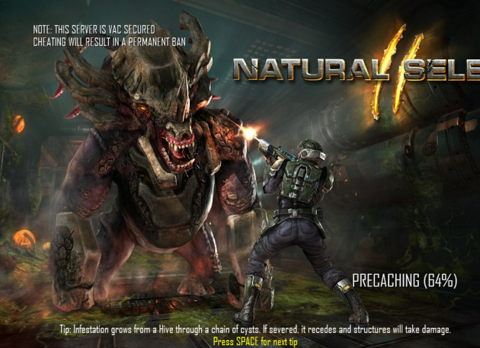
GAMEPLAY OVERVIEW:
In the default game mode (simply labelled “ns2” in-game), the two sides start with bases on different edges of the map. After appointing a commander, each team begins to sally forth from their first base to secure more ground and to interfere with the other team’s own effort.
Most of the maps are pre-existing human-made facilities, so the marines would merely be making use of what is already there. For the aliens, they must infest the map with their organic matter in order to spread their influence. All the while, players on both teams will be skirmishing with each other or building new outposts, ideally coordinating with their commanders for maximized efficiency.
Eventually, one or both teams would have grown stronger through investments in upgrades, which in turn is brought by generally good coordination on the part of the players. The battles will become much more vicious, and bases and outposts would be falling apart left and right. Eventually, assuming that one side finally obtains the momentum to overcome a stalemate, the other team’s bases would be wiped off the map, leading to victory.
Of course, this has been a great simplification of the gameplay. There are plenty of nuances – and caveats – which will be described in later sections.
FIRST-PERSON VIEW FOR NON-COMMANDERS:
All players other than the commanders have a first-person view by default, including even the aliens. In the case of the aliens, certain signature body parts are visible in order to visually indicate when an alien player character is making attacks. For example, an Onos-using player will be looking at the brute’s horn.
There is a third-person view mode, but this is officially considered to be too much of an advantage to a player, e.g. the player can look around corners rather readily. Therefore, this mode has been tucked behind a cheat mode and the developer mode.
This limitation can be worked around with third-party mods, but there have been measures implemented to detect these. It should suffice to say that always-available third-person views are officially frowned upon.
THIRD-PERSON VIEW WHEN SPAWNING:
Despite what has been said about third-person views, there is one which is officially used: this one appears when the player character is in the process of being respawned.
This is of particular importance when there are enemies who are lurking around the spawn locations. The third-person camera helps the player search for this kind of players. It is also obviously useful when there are enemies who are assaulting the base where the player character is respawning in.
Furthermore, the camera view provides one more advantage: the player character will always spawn facing the direction that the camera is looking at.
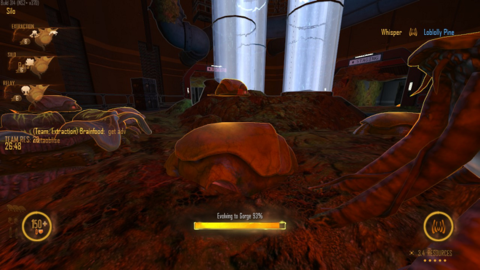
SIZES OF PLAYER CHARACTERS:
All marine player characters are human, so they conveniently have similar heights and body shapes. (The differences between the two genders are almost indistinguishable from a distance.) This also means that wherever a human player character can go to, another human can go to that place as well.
The aliens have three player characters of nominally the same size: the Gorge, Skulk and Lerk. They are only knee-high when compared to humans, and they happen to be the only ones who can enter vents. One of them, the Fade, is nominally the same size as a human, so it can only fit into places where humans can fit (which is just as well, considering its role and abilities). The last alien, the Onos, is a hulking brute which can only move through the main paths.
The aliens’ size differences are of particular significance in the gameplay. For example, there are vents which the smaller aliens can use to get around, but the bigger aliens cannot use these and thus cannot join the smaller aliens for flanking maneuvers.
HEALTH & ARMOR:
All player characters and buildings have health meters and armor meters.
The health and armor meters of a player character are represented as rings in the stats display of the first-person view, whereas the meters of other things on-screen are shown as horizontal bars.
The differences do not end here. For whatever reason, the armor meter for the player character is a partial ring, overlapping the health ring. The armor ring grows longer as the player character’s armor is upgraded by his/her Commander, but even at the maximum upgrade level, the armor ring is still only one third of the health ring’s circumference. At least the armor ring is thicker than the health ring, but the armor ring could have been designed to be clearer.
As for the gameplay significance of health and armor, it would be familiar to veterans of sci-fi shooters. Armor reduces damage inflicted on health and can run down to zero, but having health run down to zero means death for the player character. Yet, as long as the player character still has a sliver of health left, he/she/it can continue functioning like he/she/it does at full health.
HEALING MARINES:
Marines are healed in ways that – again – veterans of sci-fi shooters would be quite familiar with. Marines can be healed by coming into contact with health kits, which their commander can drop onto them or onto the ground for them to pick up. Conveniently, health kits cannot be damaged in any way by the aliens, but they do disappear eventually if they are not consumed.
Alternatively, the marines can fall back to an armory, which can heal them as long as they are in proximity, or when they are actively perusing the armory’s stores. The latter triggers the healing scripts immediately, but it is riskier because the player’s view would be obscured by the armory.
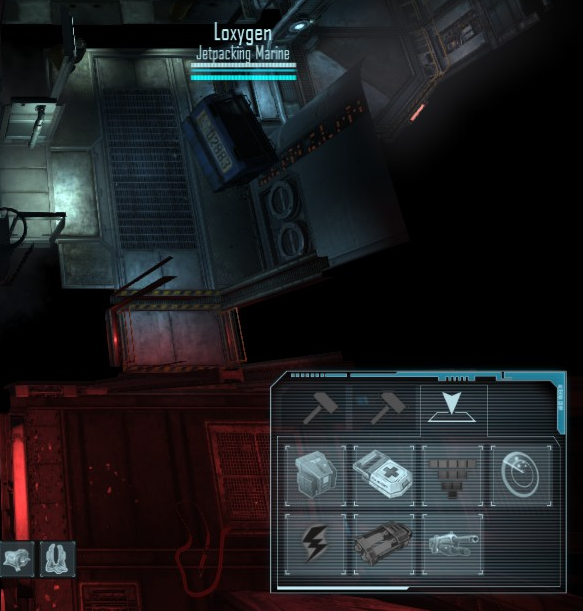
However, there does not seem to be any dedicated healing tool which a marine can equip. This means that marines cannot heal each other – which is perhaps an understandable limitation.
REPAIRING MARINE ARMOR:
The marines may not be able to heal each other, but they can still repair each other’s armor with the welder. (Somehow, the welder’s flame repairs their armor instead of fusing them into useless slag.)
In fact, this is the only way to restore the armor of marines. Their commander cannot drop armor packs, and returning to the armory does not appear to replenish the armor of marines. This does force marine players to look to each other for armor refills, however.
HEALING ALIENS:
The aliens regenerate health and armor over time, with health having a higher priority for the regeneration scripts. However, this process is quite slow, especially at the default evolution level of the aliens. The regeneration rate can be improved in a few ways, but even so, regenerating health and armor on one’s own means that the player character has to lurk out of the way for a while. This would be a waste, because the player character could have spent this time contributing to the team instead.
There are other more productive ways for aliens to restore health and armor. Firstly, they can return to the hives and linger close to them, thus providing some protection for the hives. There are also other alien structures which can speed up the healing of aliens in proximity, such as the crags.
However, the most efficient and effective way for the aliens to heal is to have the Gorge heal them. The Gorge can very quickly heal aliens, and its healing is also the only reliable way for aliens to heal while engaged in battle too. Furthermore, the Gorge player gains resources for supporting team-mates in such a manner.
MARINES’ AMMUNITION:
The marines use guns, which automatically grant them a significant advantage of range over the aliens; even the Lerk’s ranged attacks are not comparable. However, they are limited by the usage of ammunition, meaning that their guns would eventually be silenced if the marines do not monitor their ammunition and restock when necessary.
The marines’ commander can drop ammo packs for them, but each ammo pack is not guaranteed to fully refill the ammunition reserves of a marine. In fact, the amount of ammunition which an ammo pack can provide seems to depend on the marine’s gun. For example, in the case of the default assault rifle, the ammunition refill is generous. However, if the marine has a grenade launcher, the refill is barely two-thirds.
Alternatively, a marine can restock ammo by returning to an armory. However, depending on the calibre of the marines’ commander, the nearest armory may not be close in reach.
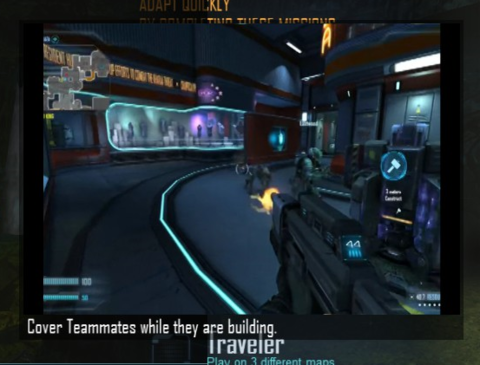
ALIENS’ ENERGY:
The aliens do not have to be worry about ammunition. Anything which they fire, be it chitin spikes, parasitic worms, loogies or such other things are grown within their bodies, so they have an unlimited supply – at least in theory.
They cannot fire their “weapons” indefinitely however. Every “shot” drains their energy reserves, which is represented by a ring on the right side of the screen. Once their energy reserves are low, their attack rates drop considerably; they have to ease off on the attacks in order to regain energy before they can go on the onslaught again.
The aliens can gain extra energy through buffs which their commander applies on them. These buffs happen to have area of effect ranges, so it is to the alien players’ benefit if they could bunch together before an assault so that their commander can apply buffs on them. Of course, such behaviour can be exploited by the marines at a very inopportune time.
RESOURCES:
As had been mentioned earlier, the aliens and the marines are fighting over “resources”. What these resources are is not entirely clear; they are represented as nodes on the ground with soft blue light coming out of them. Anyway, either side can secure a resource node by building an appropriate structure on it. Throughout the match, these nodes would be contested over, because they obviously are a factor to victory.
After securing resource nodes, resources would then flow into the coffers of the team. There is one resource counter for the team’s commander, and one for each player. The player who happens to be the commander at the time also has his/her own counter; the commander’s counter would be used when he/she is taking on the role of commander.
The commander would be using resources to build structures on the map, purchase upgrades for the team and unlock more capabilities for specific team-mates. The commander can also expend resources to purchase resupplies and buffs for other players on his/her team. A good commander is expected to balance between long-term expenditures and short-term ones, with the goal of having his/her team gain and hold ground.
Every player would spend his/her own resources in order to deck out his/her player character with personal upgrades: more gear in the case of the marines, better enhancements in the case of the aliens. However, upon death, only the upgrades which the commander has purchased for the team will be retained; everything else is lost.
Some player characters would use personal resources more often than the others. All of the marines are expected to expend their resources in order to be better equipped. In the case of the aliens, the Gorge uses personal resources the most, mainly to place additional structures that only it can build.
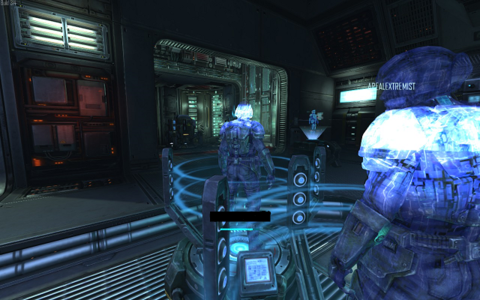
COMMANDERS AND COMMAND STRUCTURES:
The real-time strategy portion of the gameplay is experienced by the commanders of the teams. One of the players – in fact, any one player at any time – can become the team’s commander, by moving up to an empty command structure and commandeering it. In the case of the marines, that would be a command station, whereas the aliens make use of a hive.
Speaking of command structures, these are the lifeline of either. If a team has lost all of its command structures, it has lost. However, command structures are some of the toughest structures in the game, so having the other team destroy them is easier than done (unless the team is really lousy).
Each team starts with a single command structure; prior to the start of the match, the players have to decide who among them would be the commander. Ideally, this should be a player who has considerable experience with real-time strategy games, but the commander can still receive feedback from other players (usually about what they should be doing), or if the commander is particularly incompetent, vote-banned from being a commander.
Command structures have to be placed on command points. These are like resource points, but they are much larger and provide more resources. Building more command structures on other command points is vital, if only to prevent a team from being defeated by a surgical strike or an all-or-nothing onslaught by the other team.
MARINE INFRASTRUCTURE:
As mentioned earlier, the levels are man-made facilities. Therefore, it will not take much for the marines to start converting the premises to their use. In fact, they can build just about anywhere as long as they have power coverage for that location.
Speaking of power coverage, the power distribution in a level is done according to “rooms”. The sizes of the rooms vary tremendously, but the commander’s view and the other marines’ mini-maps happen to show the extent of each room. Each room is serviced by a power outlet, which is represented as a large socket.
The marines have to build a node on top of the power outlet before they can make use of any facilities which have been built in that room. There is no upper limit to the output capacity of the node, but losing the node to enemy attacks means that all facilities in that room, excluding command stations, will be powered down. Losing power in the room also causes the room to be plunged into darkness – this is an advantage for the aliens, which can still see their targets in the dark.
Of course, this means that the aliens might want to focus their attacks on a power node in a room. However, to balance against this tactical advantage, the power nodes happen to be very tough structures that can take a beating. Their power output also remains unchanged, regardless of the damage that they have taken. They are also among the easiest structures for marines to repair.
Once a room is powered, the commander can place as many buildings as he/she deems necessary, as long as there is space. However, some structures do have additional limitations which he/she should keep in mind. For example, when placing the robot factory, the player must keep the space in front of their outlets free of anything, lest the robot which has been made by the factory is unable to come out.
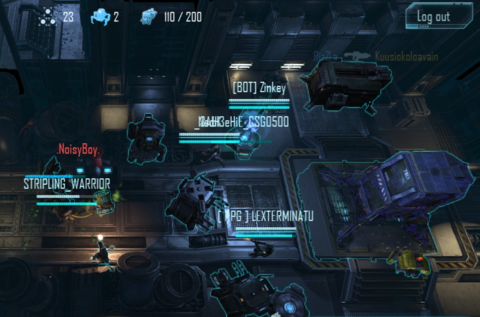
ALIEN INFRASTRUCTURE:
The aliens do not need power, but they cannot readily build stuff onto the levels either. To do so, they must spread their ‘infestation’; people who have played Starcraft, know about the Tyranids in Warhammer 40K or the bugs in Starship Troopers would find this to be quite familiar.
Infestations are spread through planting down cysts. Cysts can be placed anywhere; the placement scripts automatically make a chain of cysts to wherever the alien commander wants to spread the infestation to. Fully-grown cysts then radiate infestation.
However, cysts are only partially obscured by the infestation. They are very easy to destroy, if a marine can find a clear shot to them. On the other hand, if the marines are careless about keeping infestations in check, the alien commander can spread infestation into the marines’ own bases. Incidentally, the infestation will damage marine structures over time.
Having the infestation recede from under an existing alien structure will cause the structure to malfunction, malnourish and eventually die off. Indeed, smart marine players attempt to destroy cysts if they do not have the time to destroy useful structures, e.g. because they are at risk of being counter-attacked.
Another benefit from spreading the infestation around is that aliens which are moving on infestation move and regenerate slightly faster than those which are not. In particular, the Gorge can belly-slide incredibly fast across infested surfaces.
SUPPLY LIMIT:
Like any competently-designed RTS game, Natural Selection 2 has limitations in place to prevent either side from heavily building up any territory which it has obtained. These limitations come in the form of “supply limits”, one for each side.
Every structure which a team builds takes up a number of “supply points”. The cumulative total of “supply points” of all structures cannot go over the default 200 points. Structures which provide considerable strategic advantage, such as the marines’ armories happen to contribute a lot of points.
RESEARCH & TECH TREES:
For better or worse, Natural Selection 2’s RTS gameplay utilizes the ages-old element of “tech trees”. This is meant for gameplay balance, e.g. it is used to control the progression of the power and versatility of either side.
The marines’ tech tree would be simple for any RTS veteran to understand: their commander only needs to build the requisite buildings and purchase the “research” or upgrade options which they offer.
The aliens do not have it so easy. They have to build more hives, or upgrade their older ones; this progress is represented by the “biomass” meter, which the marines can see too. This is just as well, because the aliens’ level of biomass is an overall representation of their strength. (Incidentally, Biomass also determines the basic strength of the alien player characters.)
Even after attaining the necessary levels of biomass, the alien commander still has to manually purchase the “evolution” options. However, any options which have been purchased and completed are retained permanently, even if the aliens’ level of biomass is lowered due to the loss of hives.
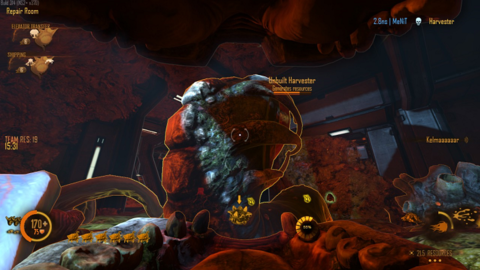
There may be a lost opportunity to make research simpler to deal with. There is a button which the commander can press to show the tech tree of his/her side and how far his/her side has progressed along it. There could have been a shortcut feature which allows the commander to start a research or upgrade option from the tech tree instead of having to select the building which offers the option.
ALIEN MATURITY:
Alien structures grow on their own once placed; they do not need actively-applied construction effort like the marines’ buildings do. However, to balance against this advantage, the element of “maturity” has been implemented.
Newly grown alien structures do not have much in the way of durability. In fact, they can be cleared away quite easily. This means that if the alien players do not consolidate after successful advances, they run the risk of being crushed in a counter-attack.
However, if the aliens have been able to hold their ground, they are rewarded with mature structures. Mature structures have more health and armor. This also means that the aliens’ first hive and the structures around it would be particularly tough if the aliens have made an effort to prevent the marines from barging through to their first hive.
MARINE WEAPONS:
The marines obviously have guns and ordnance, and will make that painfully clear to the aliens. They start with the general-purpose assault rifle, which works like veterans of shooters would expect it to.
The assault rifle can be replaced with any other primary weapon. One of them is the shotgun, which, again, veterans of shooters would be familiar with.
A sci-fi shooter would not be complete without some kind of explosive launcher, so in this game, the marines have the grenade launcher. It may not be a useful weapon to have at close quarters combat, but like the grenade launchers in many sci-fi shooter titles, the grenades can be bounced around corners. It is a mark of an experienced player if he/she can clear an alien forward base by bouncing grenades off surfaces onto obscured targets.
Next, there is the flamethrower, which is meant to be used against the infestation as much as the aliens themselves. If a marine with a flamethrower cannot tarry too long because of an impending counter-attack, he/she can still set entire rooms ablaze. Burning also causes de-buffs on aliens, reducing their performance (and gradually, their health) until the fires are put out.
Recently, the heavy machine gun has been added to the marines’ arsenal. This was to balance against alien tactics which exploited the fact that the marines need to reload the magazines of their weapons frequently.
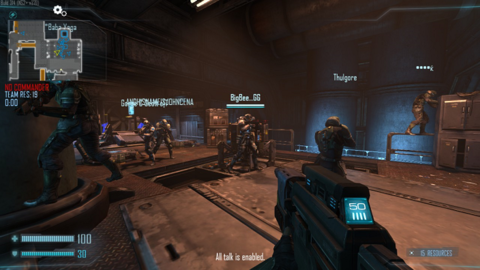
Interestingly, there are no sniper rifles or other long-ranged weapons for the Marines to use. This omission was likely intended for gameplay balance. After all, many of the maps emphasize close-quarters combat, and the aliens are not expected to fare well in maps which do not emphasize close-quarters combat.
OTHER MARINE EQUIPMENT:
Marines who go out there with just their weapons are likely to get killed eventually, and if they are not, they are not going to contribute as much to the team as they would have if they had been better equipped.
To be a team player and a better survivor, the marine should be carrying and using other gear. Chief of these is the welder. The welder replaces a marine’s switch-axe. Although it is not as savage-looking a weapon as the switch-axe, it does inflict considerable damage to armor.
More importantly, the welder can be used to repair structures and the armor of other marines. Furthermore, for reasons which are likely due to gameplay balance, repairing the armor of other marines also happens to repair the marine’s own armor.
Next, there is the jetpack. On his/her own two legs, the marine can be very easily outmaneuvered by the aliens. In fact, a marine’s backpedal speed is pathetic, and strafing can only help so much if there is not enough space. This is where the jetpack becomes handy. Bursts of the jetpack can hurl the marine towards just about any direction, including out of the reach of the melee attacks of the aliens.
Then, there are hand grenades. There are several types of hand grenades, each for a different kind of situation. For example, there is the cluster grenade, which can be tossed into vents for devastating effect against sneaky aliens who are using the vents.
It is worth noting here that the marines’ commander can drop these gear items, in addition to weapons. If the commander has resources to spare, he/she should certainly do so, in order to get the marines’ equipment up to snuff as soon as possible.
EXOSUIT:
If the marines could not force an early victory, then they would eventually have to bring out the big guns, literally. These are mounted on the “Exosuits”, which sci-fi veterans would almost immediately recognize as powered exoskeletons mounted with doles of armor and weaponry.
However, Exosuits are large targets, and the aliens which they are supposed to counter, the Onos, are formidable opponents that can still outmatch it in terms of speed. If the marines are not careful enough in providing support for the Exosuits in the form of tag-along marines or MACs, the aliens can eliminate them through attrition alone.
ALIEN LIFE-FORMS - OVERVIEW:
Each alien player starts a match as the Skulk, the aliens’ foot-soldiers. Each of the other life-forms is so different from the others in terms of capabilities and roles such that they have to be described in their own sections. Regardless, the alien team works best when they work to each other’s strengths and weaknesses.
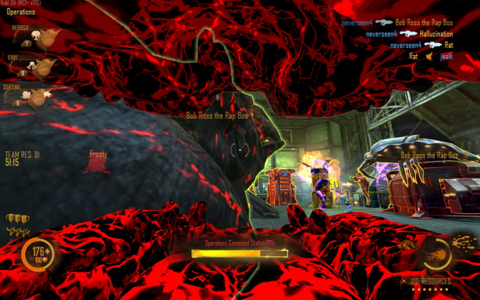
SKULK:
An alien player always starts as a Skulk. Being the default life-form, there are a few economical advantages which it has: its first biological upgrade is always free, and it is always free to form-shift into a Skulk.
That said, the Skulk is a form which rewards both inexperienced and experienced players. Inexperienced players would quickly learn that the Skulk is incredibly fast, and can get to where it is needed quite quickly. (Whether it can survive the next situation or not is another matter of course.) As a lifeform with a low profile, it can also run through vents.
Experienced players would have learned how to use its wall-climbing and wall-jumping abilities to gain considerable speed when on the move. Indeed, it can be amazing to watch an experienced Skulk player bounce across walls of corridors, evading fire all the way.
The camera is the key to learning how to use the Skulk effectively. The first-person camera remains in the same orientation regardless of the Skulk’s position; even when the Skulk is sticking to a ceiling, the orientation of the camera remains the same.
Veterans of Aliens VS Predator may not like the fixed camera because it does not show a believable view of what the Skulk should be seeing when it is sticking to vertical faces or moving upside down. Still, it makes the Skulk easier to learn.
On the other hand, the fixed camera makes it near impossible to move along a ceiling. This is because movement is relative to the camera, so in order for the Skulk to continue to stick to the ceiling, the player has to look at the ceiling. At least moving along vertical surfaces is easier, because the player can still have the Skulk strafe into walls.
The Skulk has the ability to sacrifice some speed in return for making no noise at all when it moves. This is a little useful in the first few minutes of a match, but the player might want to consider having speed over stealth at other times, especially when responding to an emergency.
Interestingly, the evolutionary upgrades for the Skulk eventually changes its role to that of shock cavalry. In particular, its ultimate ability, Xenocide, causes it to explode, showering a considerable area of effect with bony shrapnel.
The Skulk is also capable of indirect reconnaissance. Specifically, it can spit parasites at enemies, be they marines or human structures. These parasites inflict no harm whatsoever, but they allow the aliens to always see the hosts which they inhabit, even through opaque obstacles.
Obviously, this is an incredible advantage, and one that the marines have little counter to anyway, for better or worse. However, the parasites do fade away on their own eventually, and infected marines are not always alone. The marines can also see what has been infected, so they can set up an ambush.
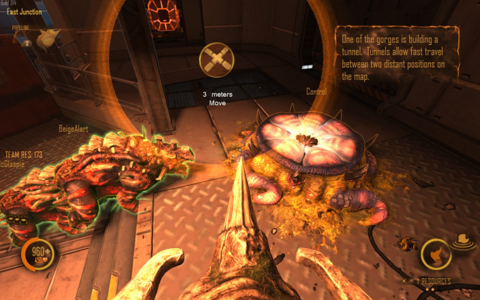
LERK:
The Lerk is the only flying life-form. It is also the only one with a reliable ranged weapon. However, it is only slightly tougher than the Skulk, and its wings do happen to have hitboxes where hits from gunfire are concerned.
Although it is the only flight-capable alien, the Lerk does consume energy when it flies. The player has to balance this against the use of its other capabilities. Besides, the Lerk’s ground speed is terrible compared to those of other aliens.
Upgrades for the Lerk turns its role to that of spoiler. It can cast an area-of-effect buff on allies which obscure them from enemy attacks, and even negate some of the damage. The Lerk can also cast an area-of-effect de-buff on marines, causing area denial in order to break up their formation.
FADE:
The Fade is a human-sized alien life-form, meaning that it would not be going into vents or other narrow places. However, it compensates for this by having the “Blink” ability: to enemies, it would appear that the Fade is making teleportation jumps. To the Fade and the other aliens, it is phasing through walls and other obstacles.
This makes the Fades incredibly useful at eliminating secluded marine assets, or for getting away. This travelling ability does cost energy, however; if the Fade player is not careful, he/she would be running out of energy when it needs to get away.
The Fade’s upgrades make it a lot more capable at its hit-and-run role. This is just as well, because such a role does necessitate considerable effort on the part of the player.
ONOS:
If the aliens could not overwhelm the marines early on in a match, they will eventually have to bring in more muscle; this would be in the form of the Onos. Where the other life-forms can be (relatively) easily gunned down by small arms, the Onos’s natural armor and durability lets it prevail in situations involving marines who are not equipped with heavy weapons.
The Onos is purely a melee attacker, for better or worse. However, it does have some moves which satisfy its need to get close to enemies as soon as possible and keep them close.
Firstly, it can make charges. It cannot use this for running gores, however. Also, making an attack causes its charge to stop. However, charging does quickly reduce the distance to the enemy. Later, the Onos can have abilities such as the ability to shield other aliens behind it more effectively and the ability to stomp the ground to knock down nearby marines.
Well-drilled alien teams will often have the Onos spearhead an attack, having it draw fire and attention while they are being healed from around corners or from afar by Gorges which are lurking at the edges of the battle. Meanwhile, the other life-forms would take advantage of the furore to make flanking attacks of their own.
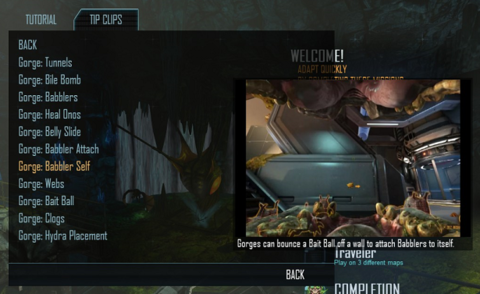
GORGE:
Last but not least, there is the Gorge, which has since been made into a mascot for the game due to its arguably comical appearance, abilities and even animations.
The Gorge is the dedicated support-oriented life-form of the aliens. It has a spit attack, but this probably would not be of much help against marines of average skill. Its more useful “attack” is the Heal Spray, which as its name suggests, can heal alien structures and other alien life-forms. Indeed, if a match is particularly heated, any responsible Gorge player is likely to be doing a lot of healing.
The Gorge is also the only life-form which is capable of building alien structures of its own. One of these is the Hydra plant, which is a short-ranged sentry that can be glued onto just about any surface. This will be useful for annoying and delaying marines, but a spirited attack would sweep even a cluster away.
Next, there is the clog, which would be quite useful early in a match, when the aliens very much need to delay the marines from trying to do an early surge. With the clogs, the Gorge can stuff doorways with gunk and force marines to shoot them down or crouch-walk under them. Clogs also happen to be completely free to build.
Then, there is webbing. The Gorge can somehow fire clots onto one surface and then fire another clot to another surface and connect them both with a sticky line. Any marine that comes into contact with the line becomes temporarily stuck. Although he/she can still shoot, he/she is very much doomed if there are aliens nearby.
GORGE TUNNEL:
The Gorge can also build a tunnel between two locations. Firstly, it has to place an outlet at one location, before making another outlet at the other location. Any alien life-form can then enter the tunnel, which is represented as a hideously huge intestine.
The reason that the Gorge tunnel gets its own section is that any player character can use it, including even marines and their Exosuits. Therefore, a strategic placement of a tunnel is still a nasty double-edged sword. This is not something that many players would know too, especially considering that most marine players are likely to just shoot anything alien in sight.
However, to lessen the advantage that the marines may get by using the tunnels against the aliens themselves, the tunnels’ environment is hostile to the marines; their armor will be rapidly reduced as long as they are in the tunnels, and Exosuits happen to be corroded alarmingly quickly.
BABBLER:
Babblers are cockroaches with sideways mouths. They are hatched from eggs that the Gorge somehow had in its belly and regurgitated.
These otherwise cute creatures follow the Gorge around as best as they could. They relentlessly attack any marines or human structures which they see, but they are not particularly resilient creatures. If they are not actively attacking the humans or following the Gorge, they would be doing silly things like making their namesake babbling noises, loitering around or looking at alien structures.
(Interestingly though, if the Gorge player chose the Phantom upgrade option, the Babblers which it spawns do not make a peep at all.)
To exercise better control over them, the Gorge can spit bait-balls which the Babblers are attracted to. If the bait-ball is attached to another alien life-form, the Blabbers will clamber over the latter and stick onto them indefinitely; effectively afterwards, they act as ablative armor.
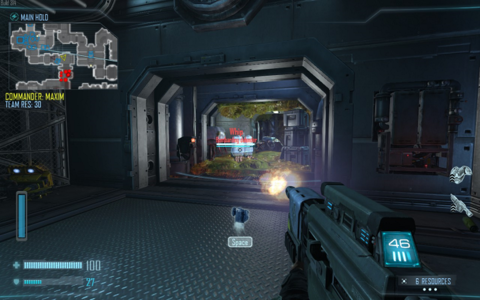
MACS & DRIFTERS:
Either commander cannot expect to always have team-mates building things whenever the commander wants them to; the other players do, after all, have their own minds. Furthermore, as the match progresses, most of the players are better off spending their time fighting and applying pressure on the enemy.
Therefore, there are builder units which can be created by either commander. These units can be directed to buildings to either repair them or complete their construction/growth.
Notably, the alien commander can create Drifters earlier than the human commander could create MACs. On the other hand, the difference in their performance is noticeable: the MACs are just as good as marines with welders, whereas the Drifters are rather slow at what they do when compared to the Gorge.
MACs and Drifters have a major problem: they do not provide vision to the commander like player characters would. This is perhaps just as well, because this limitation prevents a cheesy tactic that had become infamous in real-time strategy circles, which is to use an expendable worker unit to do reconnaissance.
ARCS:
The marines may have incredible firepower, but ultimately, they need to go through corridors and turn around corners to get to the aliens. Indeed, if the alien team is cunning enough, they can set up choke points to protect their own bases.
This is where the ARCs come in. These are sonic emitters mounted on treads, and are directed around by the marine commander. Their sonic emitters can fire waves which go through any solid obstacles. However, they can only be used to attack alien structures; they are incapable of targeting the mobile alien. Nonetheless, a gaggle of them, if escorted and defended well, can ruin entire bases very quickly.
AUTOMATED DEFENSES:
The human commander can place down sentry guns to guard a room. The sentry guns have limited arcs, meaning that they can be easily countered if placed improperly. However, if their placement has been clever, they can very much discourage any forays into the room by the smaller alien life-forms.
All sentry guns have to be powered by a nearby generator, however. This means that sentry guns have an additional point of vulnerability.
The aliens do not have such issues with their own static defences. However, the damage output of their static defences is much lower; upgraded marines can sweep them away quite quickly, if they are not bolstered by other defences such as cloaking shrouds and healing crags.
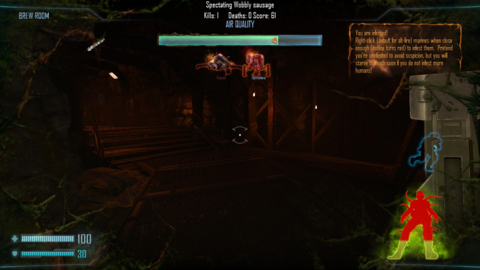
MODS:
Natural Selection 2 has an engine that was originally Source-derived (though later its coding became more original). This means that it is quite receptive to the inclusion of fan-designed mods. Of course, Natural Selection 2 is a multiplayer-centric game, so the fan-run servers which are running the game have the final say on whether to use mods or not.
An example of a mod which has become popular enough to be featured on servers is “Infested”. It is actually an entirely different game mode. In this game mode, the players all play as marines, but one of them is secretly compromised and has to attempt to tag the other marines without raising suspicion. Tagged marines then have to tag other marines until eventually all of them have been compromised. Such a mod is not entirely new in the history of video games of course, but it is understandably fun.
VISUAL DESIGNS:
Natural Selection 2 does not have cutting-edge graphics, but what it has is functionally enough for gameplay and presentation purposes. For example, the layers of textured polygons which represent the infestation look vile enough to be immediately recognizable, thus allowing players to gauge how far the alien commander has spread the infestation.
The visual designs which are more useful to gameplay include the silhouettes which show the presence of player characters. There are also the different cameras which player characters on foot have and the top-down camera which the commanders have. The latter is particularly impressive, if only because it could be implemented in what would otherwise be a first-person shooter title.
Another interesting visual design is the effects for having marines being 3D-printed into existence. This appears to involve having patches of the textures for the models of the marines being blotched onto an invisible model of a marine in neutral pose.
The aliens themselves also have peculiar visual designs for their spawning process: their eggs often spawn as models which have been scaled down into less-detailed versions of the “mature” version. The transition from the newly-laid version to the mature one is quick but progressive; there is noticeably no swapping of models.
Then, there are minor animations like how the Gorge sticks its tongue out the side of its mouth when it is sliding on its belly. Speaking of which, the Gorge’s belly-sliding is perhaps one of the most entertaining animations in the game.
There is also the amusing awkwardness of the jumping animations, which are typical of games which have been developed using the code from Valve’s Source engine as a base. The floaty jumps which the alien life-forms make are particularly notable for this.
SOUND DESIGNS:
The first audio assets which the player hears is the music. Much of it is foreboding, which is perhaps to be expected because the theme of the Aliens movies is one of the game’s sources of inspiration. On the other hand, the actual gameplay experience is not one of cat-and-mouse, especially not at this time of writing after so many balances in the gameplay and map designs have been enacted. Therefore, the effect of the music is, for the most part, easy to ignore.
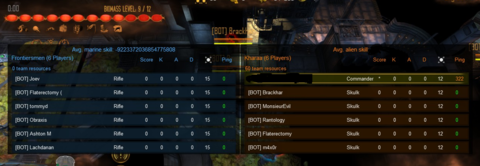
The sound effects contribute more to the gameplay experience than the music does. For example, there are the footsteps of marines and aliens, either of which are noticeably different from the other. This is of importance in the early stages of a match, when players have to listen to the approach of enemies. These sound effects eventually give way to a lot of gunfire and inhuman howls and roars as the match progresses.
There are some audio assets which are tributes to the RTS genre. For example, there are unit responses which can be heard from the MAC by ordering it around.
REGION POPULARITY:
Being a multiplayer-centric game, the fun that can be had from Natural Selection 2 is ultimately dependent on whether the game is popular or not in the player’s region of the world. If it is not, the player is very much out of luck; playing this game might be a possibly embarrassing and infuriating experience.
Currently, at this time of writing (early 2017), the game is still popular in the USA and Europe (according to data from the third-party service SteamSpy); players in this region may still find some low-ping servers that are populated by fans of the game.
For every other player elsewhere in the world though, they would have little choice but to join these servers with high pings. They would suffer automatic booting, vote-kicks or worse.
Of course, this is a problem that is not unique to Natural Selection 2; it can happen with other games with followings that are region-specific. Yet, considering that some other games can have near world-wide appeal (like certain Valve titles), it is telling of this game’s staying power.
Perhaps the game’s store page could have had some information on where in the world the game is still being played, but there is no such thing. For this information, the player would have to resort to third-party sources like SteamSpy.
OLD THIRD-PARTY DOCUMENTATION:
Natural Selection 2 was appealing enough to have a die-hard core of fans who continue to play the game to this day and even participate in tournaments, according to the game’s in-game event notification. Unfortunately, none of these fans bother to maintain third-party sources of information, namely the wikis. Even the wiki which is nested under Unknown World’s own official site is outdated.
SUMMARY:
It has to be said first in this conclusive passage that Natural Selection 2 is a well-designed game with a bold goal of blending the gameplay of two unlikely genres. When the proverbial stars are right, the game would be a blast to play, giving it an appeal that lasts years (as is the case). Unfortunately, the satisfaction of the experience is dependent on circumstantial factors like being in the right region of the world. In the absence of these factors, Natural Selection 2 is a frustrating reminder that things other than gameplay designs happen to be quite significant in the value of a game.

